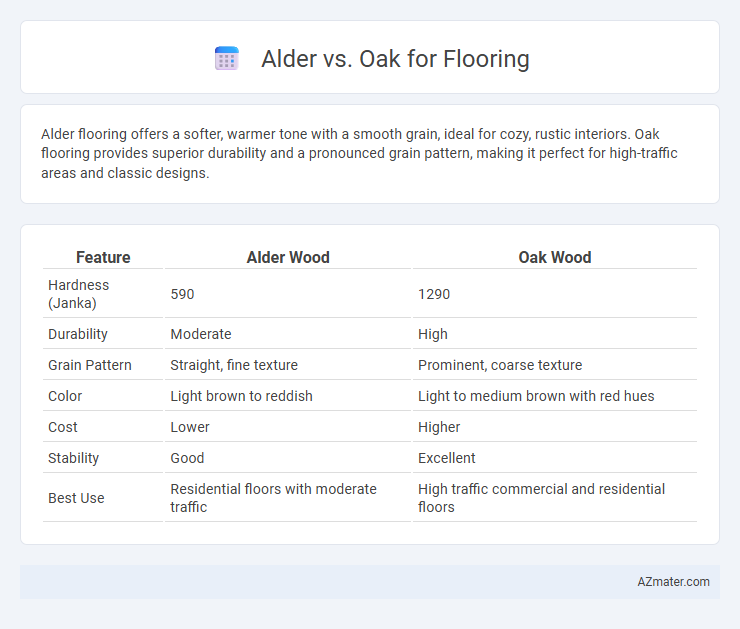Alder flooring offers a softer, warmer tone with a smooth grain, ideal for cozy, rustic interiors. Oak flooring provides superior durability and a pronounced grain pattern, making it perfect for high-traffic areas and classic designs.
Table of Comparison
| Feature | Alder Wood | Oak Wood |
|---|---|---|
| Hardness (Janka) | 590 | 1290 |
| Durability | Moderate | High |
| Grain Pattern | Straight, fine texture | Prominent, coarse texture |
| Color | Light brown to reddish | Light to medium brown with red hues |
| Cost | Lower | Higher |
| Stability | Good | Excellent |
| Best Use | Residential floors with moderate traffic | High traffic commercial and residential floors |
Introduction: Comparing Alder and Oak for Flooring
Alder and oak are popular hardwood choices for flooring, each offering distinct characteristics in grain, hardness, and color. Alder is known for its smooth texture and warm, reddish-brown tones, making it suitable for rustic or casual interiors. Oak, with its prominent grain patterns and superior durability, provides a classic look and stands up well to heavy foot traffic in residential and commercial spaces.
Wood Characteristics: Alder vs Oak
Alder wood is softer and lighter with a Janka hardness rating of approximately 590, making it easier to dent and scratch compared to oak, which ranges from 1,200 to 1,360 in hardness, offering superior durability for flooring. Oak features a prominent grain pattern with open pores, contributing to its strong texture and resistance to wear, whereas alder has a finer, more uniform grain and closed pores that provide a smoother surface but less resilience. The color of alder typically ranges from pale yellow to reddish-brown, offering warmth and subtlety, while oak varies widely from light tan to deep brown, allowing for more diverse staining options to match interior design preferences.
Appearance and Grain Patterns
Alder flooring showcases a warm, reddish-brown hue with a smooth, consistent grain that highlights subtle knots and mineral streaks, creating a rustic and inviting look. Oak flooring offers a more pronounced, open grain pattern with natural variations, featuring a lighter color palette that ranges from pale beige to rich amber, providing a classic and timeless aesthetic. Both woods deliver unique visual textures, with alder favoring softer, uniform patterns and oak emphasizing bold, distinctive grain contrasts.
Durability and Strength Differences
Alder wood is softer and less dense compared to oak, making it less durable and more prone to dents and scratches, which affects its long-term resilience for flooring. Oak, particularly red or white oak, offers superior hardness and strength, providing excellent resistance to wear and heavier foot traffic, making it a preferred choice for high-traffic areas. The Janka hardness rating for oak ranges from 1,290 to 1,360, while alder rates significantly lower around 590, highlighting oak's enhanced durability and strength for flooring applications.
Cost Comparison: Alder vs Oak Flooring
Alder flooring typically costs between $3 to $5 per square foot, offering a budget-friendly option for homeowners seeking natural wood with a warm, reddish hue. Oak flooring, priced around $5 to $10 per square foot, commands a higher price due to its durability and widespread availability in red and white varieties. While alder provides affordability with moderate hardness, oak delivers superior long-term value and resistance, influencing overall installation and maintenance expenses.
Finishing and Staining Potential
Alder wood offers a smooth, fine grain that easily accepts stains and finishes, making it ideal for achieving rich, consistent coloration in flooring. Oak features a prominent grain pattern and higher tannin content, which can create a more textured, varied look when stained, often requiring a pre-treatment to avoid blotching. Both woods respond well to finishes, but alder's uniform surface enables a more controlled aesthetic, whereas oak provides a classic, rustic charm with enhanced durability.
Installation Considerations
Alder flooring offers easier installation due to its softer texture, allowing for smoother cutting and nailing, which benefits DIY projects and reduces labor time. Oak, being denser and harder, requires more durable tools and professional expertise to handle its resistance to cutting and fastening, thereby increasing installation complexity and time. Both woods need acclimation to the indoor environment before installation to minimize expansion or contraction, but oak typically demands more precise moisture control due to its sensitivity to humidity changes.
Maintenance and Longevity
Alder floors require more frequent maintenance due to their softer wood, which is more prone to dents and scratches, while oak floors offer superior durability and resistance to wear, making them ideal for high-traffic areas. Oak's dense grain structure extends its lifespan significantly, often lasting several decades with minimal refinishing, whereas alder may need more regular upkeep and refinishing to maintain its appearance. Choosing oak flooring ensures long-term value and lower maintenance efforts compared to the softer, more delicate alder wood.
Environmental Impact and Sustainability
Alder wood is considered more sustainable than oak due to its faster growth rate and ability to regenerate quickly, reducing deforestation pressure. Oak floors, while durable, require longer growth cycles and often involve higher carbon footprints from extensive harvesting and processing. Choosing alder supports lower environmental impact through renewable sourcing and less energy-intensive production, making it an eco-friendlier flooring option.
Which is Better: Alder or Oak for Your Floor?
Alder and oak both offer unique advantages for flooring, with oak known for its exceptional hardness and durability, making it ideal for high-traffic areas, while alder provides a softer, more affordable alternative with a warm, rich color and smooth grain. Oak's higher Janka hardness rating, typically around 1,290 for red oak and 1,360 for white oak, ensures greater resistance to dents and scratches compared to alder's lower rating of about 590. Choosing between alder and oak depends on desired durability, budget, and aesthetic preference, with oak favored for longevity and toughness, and alder prized for its affordability and rustic charm.

Infographic: Alder vs Oak for Floor
 azmater.com
azmater.com